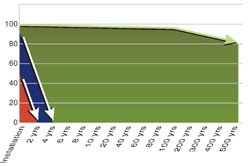Humidity & Mold as a factor in Sick Building Syndrome
In projecting a correct design for a building, and to work in a manner that benefits the micro climate internally, consideration should be taken into effect of Natural Ventilation using building materials that have high porosity, igroscopic (capacity to remove moisture and stay dry) properties, and breathability. Damages relating to moisture retention, or humidity in wall and floor surfaces, contributes to the formation of bacteria that forms mold. The prevalence of indoor dampness varies widely within and among countries, continents and climate zones. It is estimated to affect 10–50% of indoor environments in Australia, Europe, India, Japan and North America. In certain settings, such as river valleys and coastal areas, the conditions of dampness are substantially more severe than the national average.
The amount of water available on or in materials is the most important trigger of the growth of microorganisms, including fungi, actinomycetes and other bacteria. Micro organisms are ubiquitous; microbes propagate rapidly wherever water is available. The dust and dirt normally present in most indoor spaces provide sufficient nutrients to support extensive microbial growth. While mould can grow on all materials, selection of appropriate materials can prevent dirt accumulation, moisture penetration and mold growth. Microbial growth may result in greater numbers of spores, cell fragments, allergens, mycotoxins, endotoxins, β-glucans and volatile organic compounds indoor air. The causative agents of the adverse health effects have not been identified conclusively, but an excess level of any of these agents in the indoor environment is a potential health hazard.
"Microbial interactions and moisture-related physical and chemical emissions from building materials may also play a role in dampness-related health effects. Building standards and regulations for comfort and health do not sufficiently emphasize requirements for preventing and controlling excess moisture and dampness.” 1 It is estimated that new construction contains a quantity of water approximately 15% of it’s total weight.
Thus many new houses are birthed with capacity to form SBS if careful attention is not made in selecting building materials that assure the natural perspiration and breathability of walls and floors that prevent moisture from accumulating internally.

Click image to see full diagram
If careful attention is not paid to the selection of the building materials, the result is many new houses are built with the capacity to form SBS. Building materials should assure the natural perspiration and breathability of walls and floors to prevent moisture from accumulating internally.





